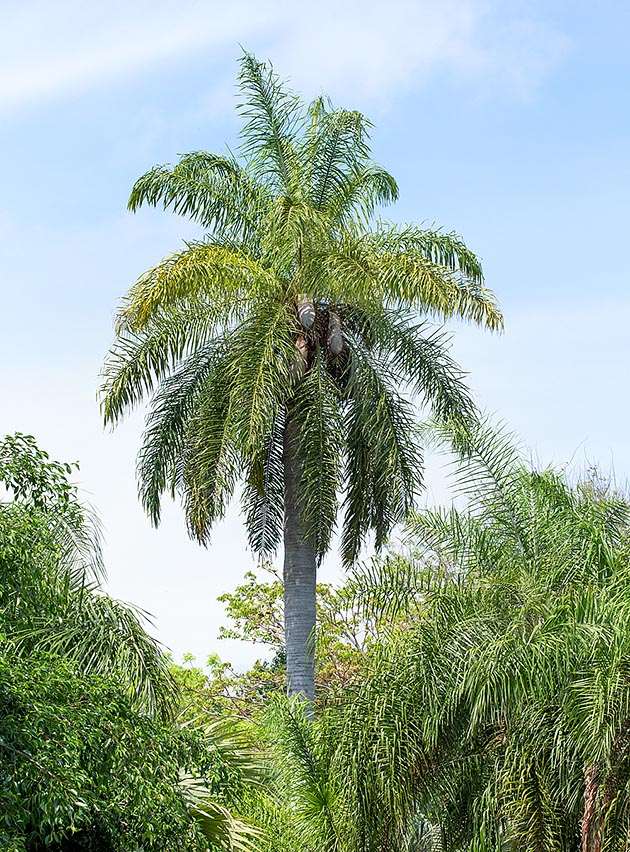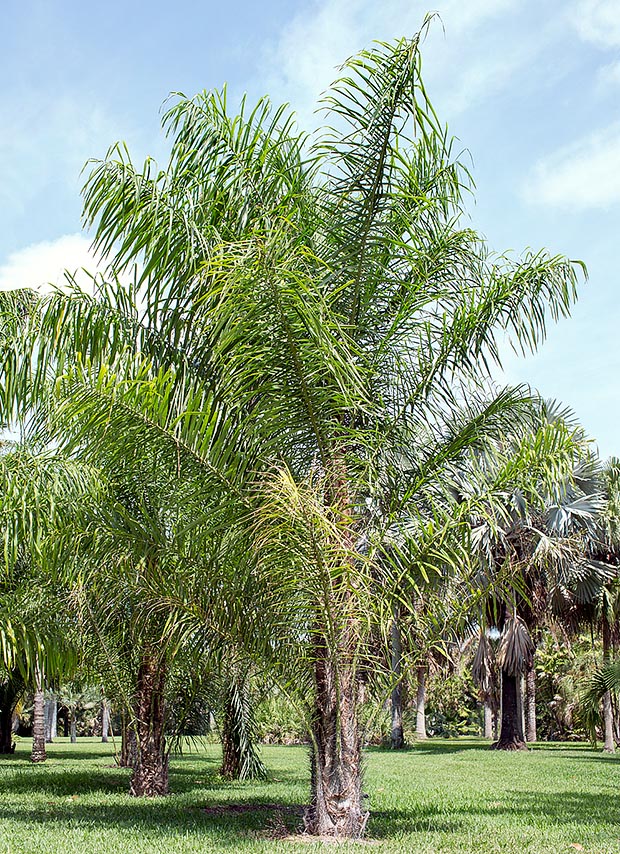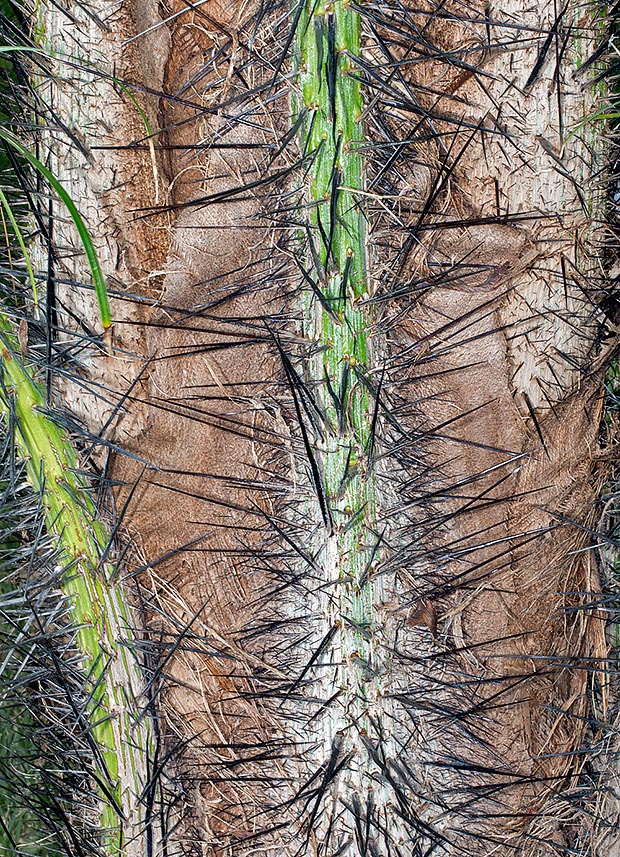Family : Arecaceae

Text © Pietro Puccio

English translation by Mario Beltramini

Native to tropical America, Acrocomia aculeata can be 10-15 m tall, with 25-40 cm of diameter © G. Mazza
The name of the genus is the Greek adjective “ἀκρόκομος” (acrocomos) = leafy, leafy on the top, in its turn derived from the substantives “ἄκρος” (acros) = top, tip, and “κόμη” (come) = hair, with reference to the thick foliage on the top of the stem; the name of the species is the Latin adjective “aculeatus, a, um” = aculeated, provided of aculei, due to the long spines of which it is provided.
Common names: macaw palm, gru-gru (English); totai (Bolivia); bocaiúva, coco-baboso, coco-catarro, coco-de-espinho, macaiba, macajuba, macauba, macauva, mucaja, mucajuba (Brazil); corozo, tamaco (Colombia); coyol (Costa Rica); corosse (Haiti); coyol (Mexico); corozo (Venezuela).
The Acrocomia aculeata (Jacq.) Lodd. ex Mart. (1834) is a very variable species with solitary stem, usually cylindrical, 10-15 m tall and of 25-40 cm of diameter, of pale grey colour, covered, but in the oldest part, by rings of thick blackish spines, 3-10 cm long, and on which are evident the annular traces of the junctions of the fallen leaves.
Dense foliage with pinnate leaves, 3-4 m long, with numerous linear leaflets with acute apex, 40-80 cm long and 1-2 cm broad, of dark green, to green grey, to bluish green colour above, whitish below, irregularly arranged and at different angles along the rachis. Petiole, 10-30 cm long, rachis and foliar base, that wraps only partially the stem, provided of spines of various length and pointing in different directions.

Dense foliage, of remarkable elegance, and fast growing in tropics where is cultivated not only as ornament © Giuseppe Mazza
Infllorescences among the leaves (interfoliar), 1,5-1,8 m long, initially enclosed in a woody bract covered by a reddish tomentum and provided of robust spines towards the apex, with ramifications of first order bearing unisexual flowers on the same inflorescence, of pale yellow colour and emitting a pungent smell, the female ones arranged at the base of the ramifications, the male ones at the apex.
Globose fruits, yellowish green when ripe, of 3,5-5 cm of diameter, containing one only seed.
It reproduces by seed, previously cleaned of the pulp, scarified and kept in water for various days, in draining loam maintained humid at the temperature of 24-28 °C, preferably in single containers, with germination times going from some months to some years.
Remarkably elegant and imposing species whose use as ornamental, in parks and gardens, is partly limited by the dangerous spines on the stem, that oblige to keep it far away from passage and parking areas.
Of quick growth, in the best cultivation conditions, is utilizable in full sun in the tropical, subtropical and marginally warm temperate climate zones, where it can stand, when adult, temperatures just under the 0 °C, provided exceptional and short lasting.
It is not particular about the soil, acidic to alkaline, provided draining, resists moderately the saltness and drought periods, but with a much slower growth.
In the origin locations, where it is amply diffused, the palm is of great utility for the local populations, the stems, long lasting, are utilized in the rural constructions, the leaves for realizing ropes, mats, fishing nets and several handicrafts objects, the fruits as food for the cattle and the extracted oil for various uses, even culinary if refined, that presents very promising characteristics for a possible large-scale production.

Due to the long spines is not good for passageways, but offers the natives textile fibres, edible oil and fruits for the cattle. From the apex of the stem, victimizing the plant, they get “edible palm hearts” and abundant lymph for an alcoholic beverage known in Venezuela as “vino de corozo” © Giuseppe Mazza
From the fermented fruits they get alcoholic beverages, as well as from the lymph gotten by cutting the apical portion of the stem, known in Venezuela as “vino de corozo”, also in this case the palm is sentenced to death.
Synonyms: Cocos aculeata Jacq. (1763); Palma spinosa Mill. (1768); Palma mocaia Aubl. (1775); Bactris globosa Gaertn. (1788); Bactris minor Gaertn. (1788); Cocos fusiformis Sw. (1797); Acrocomia sclerocarpa Mart. (1824); Acrocomia fusiformis (Sw.) Sweet (1826); Acrocomia sphaerocarpa Desf. (1829); Acrocomia guianensis Lodd. ex G.Don (1830); Acrocomia minor Lodd. ex G.Don (1834); Acrocomia lasiospatha Mart. (1844); Bactris pavoniana Mart. (1844); Acrocomia globosa (Gaertn.) Lodd. ex Mart. (1845); Acrocomia horrida Lodd. ex Mart. (1845); Acrocomia mexicana Karw. ex Mart. (1845); Acrocomia tenuifrons Lodd. ex Mart. (1845); Acrocomia cubensis Lodd. ex H.Wendl. (1854); Acrocomia vinifera Oerst. (1859); Acrocomia antioquiensis Posada-Ar. (1978); Acrocomia zapotecis Karw. ex H.Wendl. (1878); Astrocaryum sclerocarpum H.Wendl. (1878); Acrocomia glaucophylla Drude (1881); Acrocomia sclerocarpa var. wallaceana Drude (1881); Acrocomia microcarpa Barb.Rodr. (1891); Acrocomia mokayayba Barb.Rodr. (1896); Acrocomia odorata Barb.Rodr. (1898); Acrocomia erioacantha Barb.Rodr. (1902); Acrocomia wallaceana (Drude) Becc. (1912); Acrocomia ulei Dammer (1915); Acrocomia pilosa León (1940); Acrocomia belizensis L.H.Bailey (1941); Acrocomia chunta Covas & Ragonese (1941); Acrocomia hospes L.H.Bailey (1941); Acrocomia ierensis L.H.Bailey (1941); Acrocomia karukerana L.H.Bailey (1941); Acrocomia panamensis L.H.Bailey (1941); Acrocomia quisqueyana L.H.Bailey (1941); Acrocomia subinermis León ex L.H.Bailey (1941); Acrocomia antiguana L.H.Bailey (1949); Acrocomia christopherensis L.H.Bailey (1949); Acrocomia grenadana L.H.Bailey (1949); Acrocomia viegasii L.H.Bailey (1949); Acrocomia spinosa (Mill.) H.E.Moore (1963).
→ For general notions about ARECACEAE please click here.
